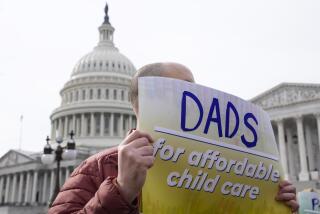U.S. child-care aid would supercharge moms’ employment, study says

- Share via
Subsidizing child care, a key part of President Biden’s pandemic recovery legislation that has so far failed to pass into law, would increase the number of mothers in the workforce and boost wages for industry workers, among other social and economic benefits, according to a new study.
For households making up to 250% of the national median income — which is $90,657 for a family of four — a federal program that would cover child-care costs exceeding 7% of that family’s income would boost mothers’ employment by 6 percentage points, and 10 percentage points for those working full time, economists led by Jonathan Borowsky, a postdoctoral associate at the University of Minnesota, said in a paper.
“The model estimates suggest that expansion of child-care subsidies would mitigate family income gaps in access to licensed care facilities, moving families from unlicensed care to center-based care in particular,” according to the paper circulated by the National Bureau of Economic Research.
“These shifts also facilitate meaningful increases in maternal employment and imply improvements in the quality of care experienced by children.”
The U.S. is an outlier among wealthy nations in not guaranteeing child-care assistance for working parents — a problem exacerbated by the pandemic in driving up already-high facilities costs, impacting children’s preparedness for school and forcing more women out of the labor force than men. Lawmakers have proposed various ideas to help bolster the industry, though none have yet succeeded.
Suffering from burnout? Many parents are, and experts have advice.
The paper’s authors created three models, each reflecting different degrees of subsidies, based on existing legislation. The broadest, which includes capping the amount of money a family spends on child care at 7% of income, is based on Biden’s proposal in the Build Back Better Act. In that scenario, the gains in the job market would be driven by low-income mothers, whose full-time employment would probably increase by 18.2 percentage points.
Some 68% of U.S. mothers with children ages 3 to 5 are employed, only higher than eight other countries out of 40 in the Organization for Economic Cooperation and Development, the authors found. A broad expansion in child-care subsidies would increase that share to 78%, which would catapult the U.S. into ninth place in mothers’ employment among the richest nations.
By increasing demand for the services, child-care subsidies would boost hourly wages for industry workers, who make an average $12.12 per hour and are disproportionately women of color. Wages could increase as much as 29% for teachers with a bachelor’s degree, and 14% for those without one, the authors found.
While some legislation includes a wage floor, or a minimum-wage level, for the child-care workforce, the paper’s authors found it wouldn’t necessarily be needed because natural market forces would push wage increases close to that of the prescribed floor.
Child-care workers have been slow to return to the industry since the pandemic. The availability of higher pay in other jobs has led many of the workers to leave the industry altogether.
While some federal subsidy programs already exist, such as Head Start, inadequate funding means they reach only a fraction of eligible children, the authors found.
More to Read
Inside the business of entertainment
The Wide Shot brings you news, analysis and insights on everything from streaming wars to production — and what it all means for the future.
You may occasionally receive promotional content from the Los Angeles Times.











